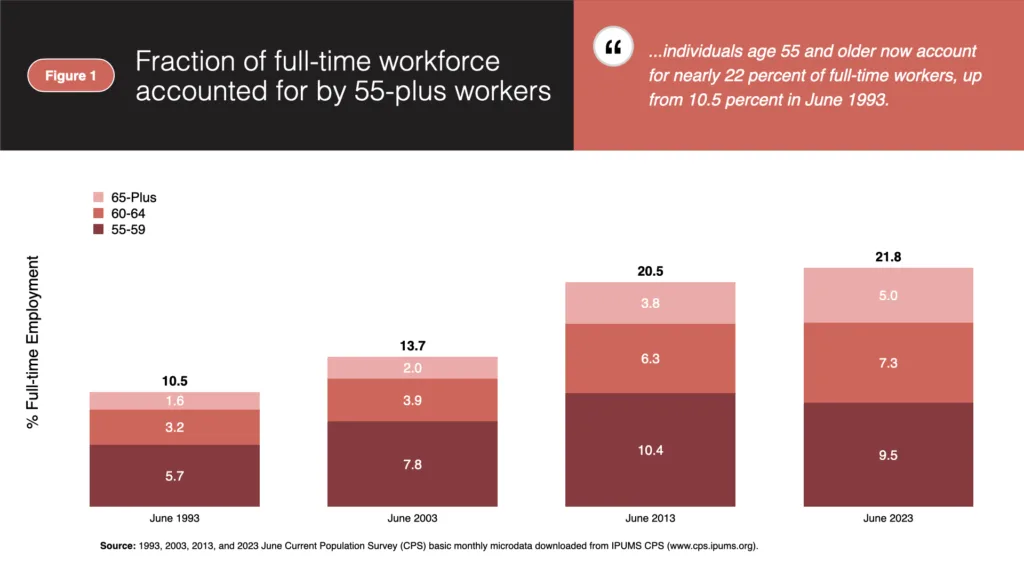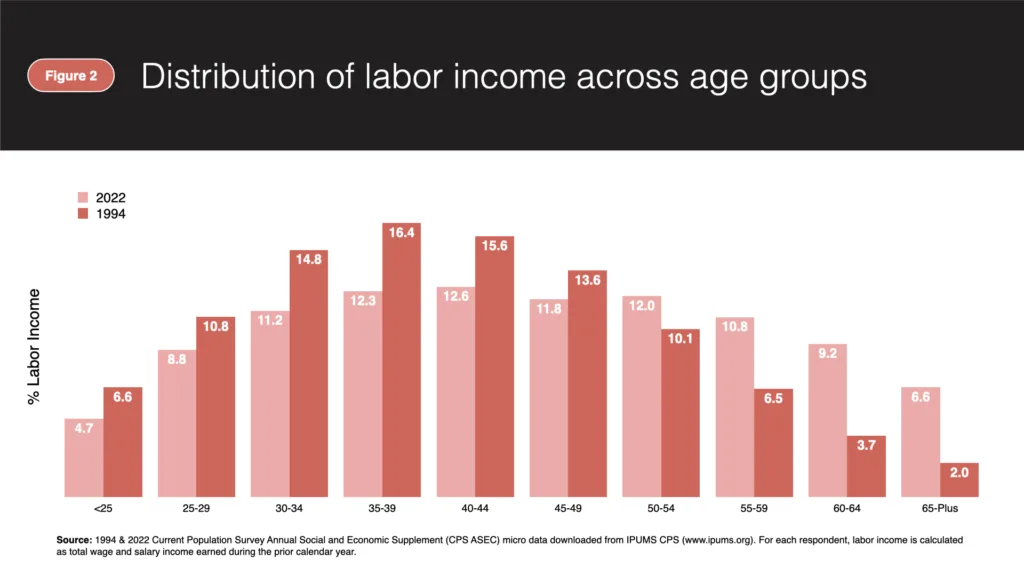Key Takeaways
- Labor market policies and employment practices have historically been designed with prime-aged workers in mind, yet the economic importance of older workers is growing rapidly.
- Workers aged 55-plus have grown from less than 11 percent of the full-time workforce 30 years ago to nearly 22 percent today.
- Over one-in-four dollars of labor income in 2022 was earned by a worker age 55 or older, up from less than one-in-eight three decades prior.
- Going forward, the health and productivity of the American workforce will depend on recognizing the importance of older workers and developing labor policies and employment practices that meet the needs of every generation.
For decades, labor market policies and employment practices have emphasized the “prime working age” population, which includes people aged 25-54. This focus stems from the sheer size of the group, as well as its reliably high labor force participation. In contrast, workers age 55 and older have historically been a much smaller group with lower labor force participation; consequently, their role in the labor market has received comparatively little attention or care. However, rapid demographic change and shifting labor supply decisions have greatly amplified the economic power of older workers and underscored a fundamental truth: Going forward, the health and productivity of the American workforce will depend on recognizing the importance of older workers and developing labor policies and employment practices that meet the needs of every generation.
One reason that the prime-age workers receive so much attention is that they have historically accounted for the vast majority of full-time employment, making them the primary source of labor income, consumer spending, income taxes, and other critical economic contributions. On the other hand, fewer than one-in-nine full-time workers were 55 or older only 30 years ago. However, the U.S. population has aged significantly since then and people are increasingly choosing to work later in life. The net effect of these changes is that individuals age 55 and older now account for nearly 22 percent of full-time workers, up from 10.5 percent in June 1993. This dramatic increase is mostly due to the growing role of workers aged 60-plus, whose representation in the full-time workforce grew from less than five percent in June 1993 to 12.3 percent in June 2023.

As people aged 55-plus have established stronger ties to the labor force, their role in earning income has grown correspondingly. The figure below illustrates this by comparing the distribution of labor income across age groups in 1994 and 2022.1 In the former year, workers under age 55 controlled nearly 88 percent of labor income, with over two-thirds of that share accruing to workers age 30-49. By 2022, the fraction of labor income earned by those aged 55-plus had skyrocketed from 12.1 percent to nearly 27 percent. This shift has had far reaching implications, including a greater reliance on older workers for consumer spending and tax revenue at every level of government.

Awareness about the growing role of older workers is rising quickly. For example, a pandemic-driven decline in labor supply among people age 65 and over created significant gaps in the labor market and forced employers to recognize the central role that older workers play in supporting their operations. Lessons such as these have highlighted a tremendous opportunity to develop labor policies and employment practices that support an increasingly age-diverse workforce. AARP has been at the forefront of innovation in this area for many years. Recent examples include our ongoing Living, Learning, and Earning Longer initiative, our work on the business case for healthy longevity, and our extensive Longevity Economy® research. These and other efforts promote an environment in which workers of all ages are empowered to pursue employment goals that match their unique needs, resulting in economic gains benefiting every generation.
- This income data comes from the Annual Social and Economic Supplement (ASEC), which is administered as part of the March Current Population Survey (CPS). In these data, reported labor income reflects total wage and salary income earned during the prior calendar year. ↩︎

 "
"
